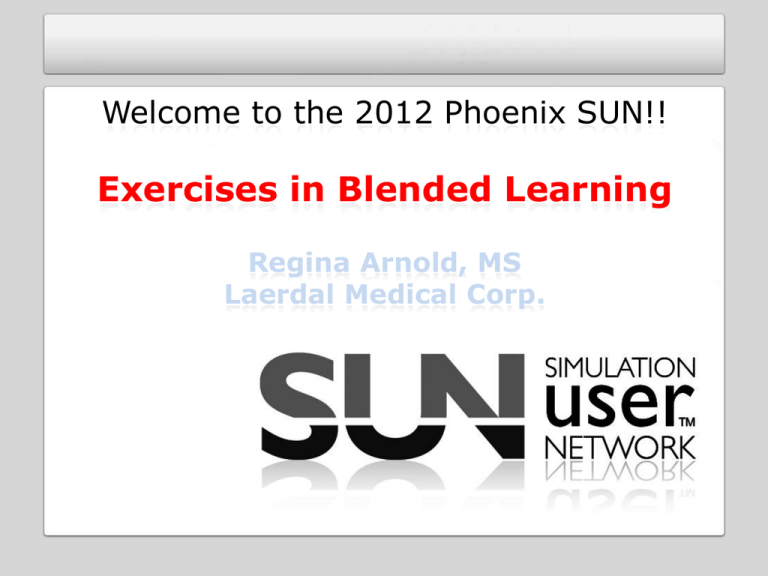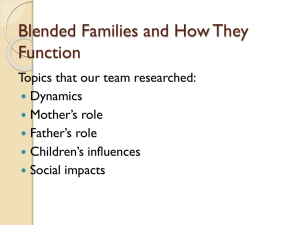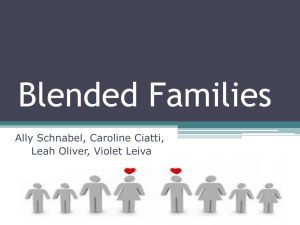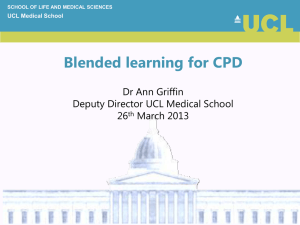- Laerdal
advertisement

Welcome to the 2012 Phoenix SUN!! Exercises in Blended Learning Regina Arnold, MS Laerdal Medical Corp. Disclosure Statement Participants must attend the entire session in order to earn contact hour credit. Verification of participation will be noted by learner initial/signature on the roster. Planners and presenters have declared the absence or presence of any real or perceived conflict of interest which might influence the planning of this activity. Kelly McKeever has identified the following real or perceived conflicts of interest: “Regina Arnold” is an employee of Laerdal. No commercial support has influenced the planning of the educational objectives or the content of this activity. If there were any commercial support provided for this activity, it would be used for events that are not related to continuing education. There is no endorsement of any product by the provider or NCNA associated with this activity. It is expected that no presentation will relate to products governed by the Food and Drug Administration. But, during the course of this activity, if there is discussion related to such products, FDA-approved and non-approved uses will be disclosed to participants. Learning Objectives… • Define Blended Learning • Value Simulation as a Critical Component of Blended Learning for Healthcare Learners • Recall the Components of the Circle of Learning • Discuss how a Current Lesson Module can be Converted to a Blended Approach • Demonstrate operations of HeartCode BLS or ACLS • Utilize Team Simulation for BLS or ACLS training • Recall 10 Tips for Successful Blended Implementation Introduce Yourselves… • Name • Where are you from? • What are your interests in blended learning? • What are your expectations for today’s session? What is Blended Learning? “The combination of different training media (ie., technologies, activities, and types of events) to create an optimum training program for a specific audience. The term “blended” means that traditional instructor-led training is being supplemented with other electronic formats” (Bersin, 2004). Is Medical Simulation a Blended Approach? Dr. David Gaba (2004) has defined simulation as a “ ...technique, not a technology, to replace or amplify real experiences with guided experiences, often immersive in nature, that evoke or replicate substantial aspects of the real world in a fully interactive fashion” (p. i2). He describes a simulator as a “device” that mimics a real patient or a part of the human body, and that is capable of interaction with the learner. Blended Learning Curricula Are NOT Successful When They… • Consist of flat e-Learning on a page (Reading Text on a Computer) • Consist of random, unlinked activities • Are instructor – focused • Were built without deliberate instructional design techniques • Don’t focus on performance Blended Implies Content and Concept Integration • Curriculum Integration • Increasing Level of Difficulty • Feedback to Learners • Repetitive Practice So Why Should You Implement a Blended Solution? Faculty/ Program Benefits • • • • • • • • • • Increase Performance Increase Test Scores Improve Critical Thinking Improve Patient Outcomes Reduce Training Cost / Time Burdens Standardize Education Benchmark Performance Resource for Adjunct Faculty Curriculum Integration Meet Accreditation / Oversight Educational Standards Student Benefits • • • • • • • • Engage in Active Learning Opportunities Learn via Multiple Learning Strategies Flexible Learning Times Increase Practice / Application Time Improve Critical Thinking Improve Performance Improve Test Scores Develop Adult Learning Skills Where Are We Today? How Does Your e-Learning Match Up? How To Design Simulation – Based Blended Learning • • • • • • Begin with the End in Mind • Learning • Performance • Critical Thinking Concepts • Patient Outcomes • Individual Performance • Team Performance & Communication • Environment/ Culture • Systems Analysis Benchmark Success – ‘What Does it Look Like?’ Develop Student-Centered, not Instructor-Centered Learning Activities Set the Students up for Success Integrate and Weave Concepts through the Blend Plan the Time to do it Right “We can only consider what is learned, as being taught.”… Anonymous Student – Centered Activities Bloom’s TaxonomyHow Do We Increase Critical Thinking???? Student – Centered Activities Laerdal Circle of Learning A Blended Learning Model… Knowledge Acquisition The process of acquiring or revising knowledge. List 3 Examples of Activities for your Blended Approach. Skills Proficiency The development of psychomotor skills to master practical procedures. List 3 Examples of Activities for your Blended Approach. Computer Simulation The use of a computer program simulating patients to apply concepts and integrate decisionmaking and clinical skills. Activity: List 3 Examples of Activities for your Blended Approach. Hint: What other forms of computer simulation exist? Simulation In Teams The use of teamwork during a simulated patient exercise to experience and practice a realistic clinical situation. List 3 Examples of Activities for your Blended Approach. Reinforcement - Clinical Experience Learning through reflecting on the treatment of real patients, personal tuition and exchange of knowledge with colleagues. List 3 Examples of Activities for your Blended Approach. From Learning to Behavior, to Results Measure, Analyze, Revise, Improve From Learning to Behavior, to Results The Kirkpatrick Model of Evaluation Let’s See It in Action! Case Study – From the Field Northwestern Memorial Hospital is an 897-bed tertiary-care urban teaching hospital. The hospital’s Medical Intensive Care Unit (MICU) is a 20-bed facility that treats approximately 1,500 patients annually. Medical Residents insert the greatest number of central lines at the MICU – it is believed that improper technique increases the risk of catheter-based infections. The Residency Director hypothesizes that training the residents on a standardized approach to central line insertion will reduce the incidence of CBI. Case Study – Northwestern Hospital Kirkpatrick Level 4 – Results Current MICU Catheter-based infections (CBIs) cost approximately $82,000 and 14 additional hospital days. 3 – Behavior Physicians demonstrate inconsistent approach to performing central line insertions. Some techniques increase risk for CBI. Expected Reduce occurrence of CBIs by 15%. Reduce CBI costs by $700,000 Physicians perform central line insertions according to validated process. 2 – Learning No standardized approach. Desired results Score at least 95% on knowledge warrant standardized approach. 1 – Reaction Nursing staff report frustration with inconsistent physician approach assessment and perfect score on at least 2 standardized central line insertion simulations. 95% of course participants would recommend course to a colleague Nursing staff report higher satisfaction Level 4: Results Today’s Case: Problem Statement St. Elsewhere Hospital is an 650-bed community hospital with an Emergency Department as well as primary stroke and heart attack services. The hospital’s Medical Surgical Unit (Med-Surg) units are large and are staffed by more than 350 registered nurses. Two nursing schools in the area have a total of 40 students on the unit every day with clinical instructors. The hospital is renewing its Chest Pain Certification this year, and has been evaluating cardiac data on all units. The average resuscitation rate from V-Fib arrests in the hospital is 55%, above the national average. However, on the med-surg units, it is only 30%. The response time of the Emergency team is 5 minutes to the unit. Surveys have identified that the nurses deliver disorganized, ineffective care in the initial minutes of these emergencies. The Chief Medical Officer tasks you with designing education to improve this problem, deliver training to the nurses, and requires all students who will be on the units to complete the training as well. Today’s Case – What Does Success Look Like? Kirkpatrick Level Current Expected 4 – Results Med Surg Resuscitation Rate from Vfib is only 30%. Improve Resuscitation Rates to 50% or better. 3 – Behavior Rapid Reponse Teams are called, but arrive to find disorganized care to the patient, often with no, or incorrect treatment being provided to the patient. Nurses and other floor staff will provide standardized, continuous, and consistent care to patients who are found unresponsive with no pulse. 2 – Learning No standardized approach. Desired results warrant standardized approach. 1 – Reaction Nursing staff report frustration with equipment and not enough practice time with megacode situations on the unit. Basic equipment in the patient room is often missing. Score at least 95% on knowledge assessment, achieve skill proficiency, and perform to 95% on two cardiac arrest scenarios outlined by the American Heart Association and the hospital resuscitation policy. 95% of course participants would recommend course to a colleague Nursing staff report higher satisfaction Equipment is standardized and maintained by ancillary staff Design for Success 10.5 Tips for Success 1. Begin with backwards design 2. Determine what goes where 3. Build learning communities into the design 4. Set clear expectations & detailed student directions 5. Orient learners to the course / blended learning process 6. Communicate in multiple modes – learning preferences 7. Use a variety of voices / media types 8. Elicit frequent feedback 9. Present a friendly tone 10.Keep organization simple & consistent 10.5 Educators: Revisit, Review, & Revise - Adapted from K. Teeley, RN: Simmons College Let’s Design the Blend! Begin with the End in Mind !!! (Nursing Education: First 5 Minutes Treatment for Cardiac Arrest) •Group 1: What Cognitive Topics/ Objectives Need to be Achieved? How can we use data to convince people this is important training and that behavior needs to change? •Group 2: What Skills do the Nurses need to have Competency in? How would you design the skills competencies? •Group 3: What Types of Computer Simulation or other Application – Level activities exist that you will use to reinforce concepts and integrate skills into practice? •Group 4: Design 2 Simulations to utilize during Team Training. •Group 5: What topics would you cover in Debriefing and why? Would they differ for student nurses and practicing RNs? Why or why not? •Group 6: How can you continually support Behavior Change after the training? •Group 7: How would you evaluate if any systems/ environmental factors need to be changed to support the new performance standards? How would you design a program so people maintain their practice skills? Course Plan & Execution – Rotate Through Skills Stations Course: First 5 Minutes for Med-Surg Nursing •Cognitive Activities: Pre-test, Survivor Video Testimonial, Hospital and Unit Statistics, First 5 Minutes Webinar, Video and Performance Checklist Download, Policy/Procedure Download, Post-test •Skills Assessment: Code Cart (Backboard & Defib Pad review), BVM ventilation of patient, Oxygen devices & flowrates, Calling for help, Patient assessment, Quality of Compressions (Voice-Activated Manikins and Skill Reporter) •Students Only: Case Discussion during Class: Michael Swan •Computer Simulation: Heartcode BLS or ACLS with Skills Competency on voiceactivated manikins for Certification •Simulation in Teams: Complete two successful simulations as team leader. 1 patient in bed, 1 patient in bathroom •Debriefing: Major points: Calling for Help Process, Initiating Supine on Flat Surface or Backboard, Performing High-Quality Chest Compressions •Reflection (Students): Homework assignment Reinforcement/ Patient Care (Staff): On-unit reminders, supervisor support, charge nurse bedside debrief at actual events •MOC Program set up every quarter for everyone to refresh. Education reproduced for new hires. Monthly mock codes done on the floor with mobile simulation. Equipment and policy changes to improve resources for staff Thank You!! References Bersin, J. (2004). The Blended Learning Book. Pfeiffer: San Francisco. Cohen, ER, Feinglass, J., Basuk, JH, Barnard, C, O’Donnell, A, McGaghie, WC, & Wayne, DB. (2010). Cost savings from reduced catheter-related bloodstream infection after simulation-based education for residents in a medical intensive care unit. Simulation in Healthcare, 5(2), 98-102. Gaba, DM. (2004). The future vision of simulation in health care. Quality and Safety in Health Care, 13 (Suppl 1), 2-10. Issenberg, SB, McGaghie, WC, Petrusa, ER, Lee Gordon, D, Scalese, RJ. (2005). Features and uses of high-fidelity medical simulations that lead to effective learning: a BEME systematic review. Medical Teacher, 27(1), 10-28. University of Central Florida. (2012). The Blended Learning toolkit, available: http://blended.online.ucf.edu/blendkit-course/







